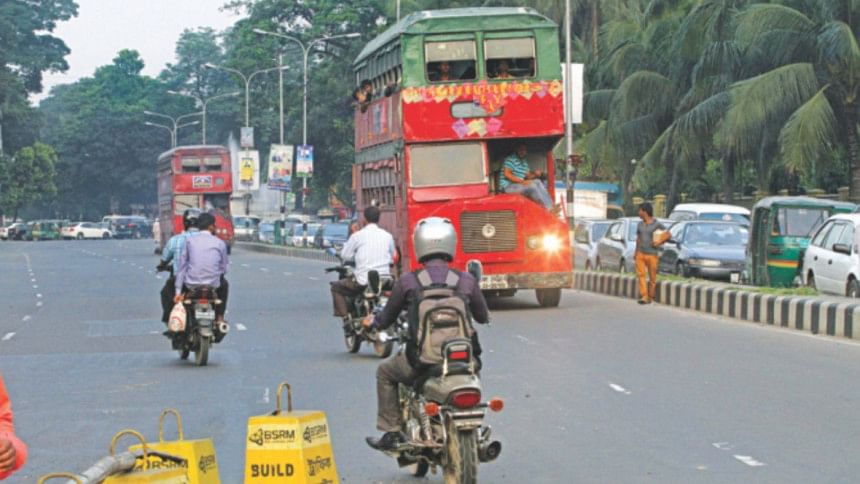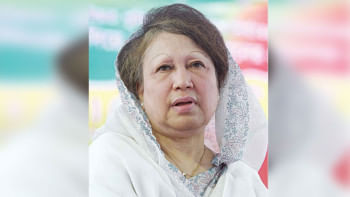Street abuse: Drawing the line

The abuse of our streets seems to have reached monstrous proportions. At the root of it all is a phenomenally growing aura of indiscipline that borders on the unbearable and challenges one's physical, emotional, and even financial endurance. With indiscipline, unfortunately, also comes a disrespect and disregard for others that is displayed brazenly by people from all walks of life – from the pedestrian crossing the streets "anywhere" and "anytime" and the rickshaw-puller occupying centre-street to the uncivil car and bus drivers blocking left lanes and making ridiculous U-turns, motor-bikers striding footpaths and ignoring traffic directives, masses of bus passengers standing in the middle of the road in waiting, footpath occupiers taking up all the walking space and much more. These are serious behavioural problems that need to change.
I had written earlier (TDS – August 2014) on how Dhaka's street users are a study in behaviour dysfunction. Others have also written extensively on the woes of the streets. But things seem to have gone from bad to worse. Apparently no one who can do something about the matter is able or listening.
A major issue with our streets has to do with normlessness. Where norms are followed in many other situations (homes, offices, airports, banks, etc.), just about anything goes in Dhaka's streets. It exposes a side of us as selfish, pushy, arrogant, nasty and oblivious of others. Whether this reflects who we are as a people or whether the street conditions have driven us to turn roguish is a moot question.
There are many probable solutions for the traffic mess. Some strategies require long term thinking and include public education on street norms, improving public transportation, increasing road capacity, severely limiting new private car registration, creating new development hubs in other parts of the country to redirect labour migration, relocating businesses from roadsides, implementing zoning laws, building high-rise parking spaces, getting slow-moving traffic off the streets, planning one-way streets that change direction depending on traffic flows, and installing parking meters, to name a few.
For immediate relief, however, the need is stronger enforcement of discipline and innovative behaviour modification strategies. The fact is we are not incapable of showing discipline. For example, during traffic weeks, much greater deference is shown to the concept of discipline. Within the Cantonment, street behaviours are quite well-regulated. And, yet, during normal times, incivility is at its peak. Clearly, when there is a disciplining force at work, orderly traffic flow is more easily achieved.
Given the mammoth traffic problem that is horrendously costly and debilitating for the nation, it is important to disaggregate the variety of elements contributing to the traffic conundrum and seek solutions for each particular element within a larger framework.
For lack of space, let me elaborate on one particular element that can be better managed using a three-pronged strategy to provide immediate relief while long term strategies continue to be developed. Many of the problems, the readers will probably agree, are at the traffic intersections. A great number of violations occur at these intersections, mainly because there is no norm on who should wait where and who gets to enter the intersection when. It may be noted that there is a code of conduct for traffic entering intersections in the developed world. There is no such norm in Bangladesh. Most problematic is the absence of clearly drawn lines at the intersections to demarcate where the vehicles must stop until permitted to proceed. Thus all vehicles keep pushing as far as they can, in utter disarray, while narrowing the space at the intersection, thereby obstructing smooth flow. As a result, the clog up is often colossal and unrelenting.
The first strategy thus is to draw lines in red and white at the intersections to clearly demarcate where vehicles "must" stop. This is also a nice CSR opportunity, as well as a public-private partnership (PPP) prospect for all affected parties to engage in a collaborative effort to bring sanity quickly.
Second, given the serious deficiency in the number of law enforcers for all the (major) intersections in the city to apprehend violators, I propose a SWARM & STING FORCE (SSF). This is a "mobile "special force, moving in teams of 15-30 all over the city, in special and imposing uniforms, who will show up like bees, unannounced, at major (and some minor) intersections known to be traffic trouble spots.
What the FORCE must use is the element of surprise: to apprehend the motor-bikers on the footpaths, the impatient pedestrians crossing the streets haphazardly, the left lane blocking vehicles that must be "forced" to turn left (this needs painting arrows at the intersections), the buses stopping at the intersections for passengers, the parked cars that narrow traffic lanes, the cars in the inner streets that in their hurry and rudeness form new lines and block traffic coming from the opposite direction, and the idiot driver driving on the wrong side of the street. Other similar violations, too numerous to list here, will also come under their ambit.
Of particular importance is that the FORCE must be empowered to impose serious penalties on "all" violators. Their strength will be in their numbers and they must have the authority to take "any" violator to task. Thus, when vehicles cross the line and block the intersection, impede traffic flow on the left lane, or drive on the wrong side of the road, the penalties must be swift and sharp.
Buses blocking the intersections should be especially taken to task. The license of some of the drivers must be impounded for a certain period. In fact, the intersections should be off-limit to picking up passengers or dropping them off.
Many of these offending bus and also car drivers may be made to complete a training or certification programme before they can get back their licenses. If databases can be maintained, repeat offenders can be tracked using computers and long-term driving bans imposed on them.
The FORCE could also initially help train pedestrians and make them cross in groups using zebra crossings. Violators could be fined a substantial fee for crossing at the wrong places or detained in a special enclosure in lieu of a fine. Beggars and hawkers on the streets, rickshaws, motor-bikers and smaller transport vehicles are other categories of offenders that must also be dealt with in special ways.
Third, extensive media involvement is needed in the initial phases to highlight the behaviour changes being targeted and the consequences for violations. This will be critical and must be innovative and persuasive. The universities and media houses could collaborate to come up with interesting communication ideas (with awards for the best ideas). Media must thus continue to inform, persuade and remind the public of the new street norms and is the final piece of the three-pronged strategy to manage the traffic better.
Fresh new paint on Dhaka's streets will convey a clear message about the traffic authority's new resolve. The surprise effect of the newly empowered SWARM & STING FORCE will bolster implementation. Media will creatively inform and guide. Properly coordinated, the much needed behaviour changes will provide deep relief to the weary, harassed and tormented street users.
The writer is Vice Chancellor of BRAC University.

 For all latest news, follow The Daily Star's Google News channel.
For all latest news, follow The Daily Star's Google News channel. 



Comments